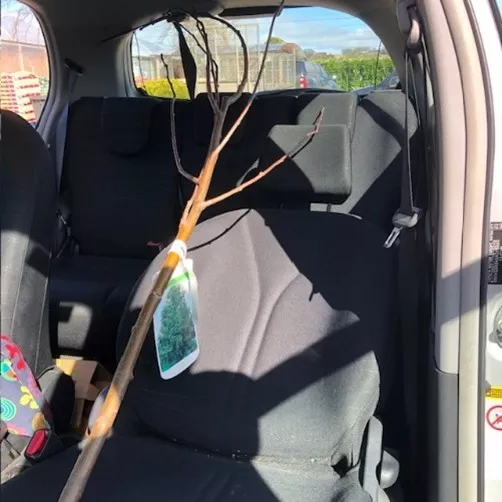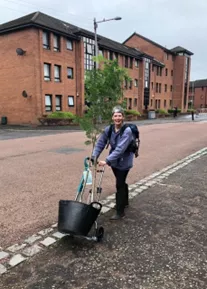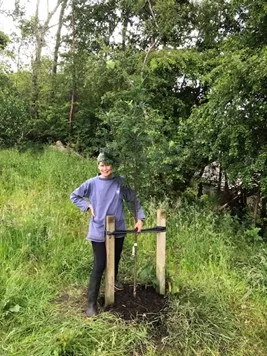
It all started a few weeks before RCPCH Conference in Glasgow in March. I’m a member of the College’s Climate Change Member Reference Group and we’d agreed that the prize for the winning abstract in the climate change session would be a voucher to buy a tree. It clearly wouldn’t be practical for the winner to have to transport an actual tree home, but we were keen to have one on the stage. As I’m based in Glasgow, I agreed to help source one and find somewhere locally to plant it afterwards.
Where would I plant a tree? I live in a flat and we already have as many trees on our back green as the space can support. What sort of tree was envisaged? What size? What species? Bare root or in a pot? The answers came promptly: in a pot...maybe an apple tree... whatever size we can get for about £40. I began to warm to the idea and explored public spaces that might accommodate another tree.
The local Children’s Wood and the Children’s Garden at the Botanics already had plenty of apple trees. How about the Local Nature Reserve opposite the health centre where I worked? Learning that soil testing could be needed before planting an edible fruit tree on a brownfield site, I decided to explore native crab apple trees or a rowan instead. An excellent nursery just outside Glasgow was well-stocked with native rowan trees. So that was that was where the love affair began.
With now just days until the conference, I was confident I had a place to plant...
Confirming ownership of the site I’d selected for planting wasn’t straightforward. A spot by the fabulous slide built into the bank between the road and the canal and nature reserve seemed somehow appropriate for paediatricians to place a tree, given the slide’s popularity with local children. The Health Board had been involved in the landscaping, but the Board’s greenspace officer advised they didn’t own the land. Perhaps it was Scottish Canals? A contact there replied to my email with enthusiasm…..but apologies that they didn’t own it either. The Glasgow City Council greenspace and biodiversity team confirmed the land was council-owned, and a native rowan would be an appropriate replacement for a dead sapling at the selected site.
With now just days until the conference, I was confident I had a place to plant and knew what species would suit it. Enough of the online searching/swiping – it was time to meet my tree in person. Before setting off for the nursery I was assured that a 2–2.5m tree in a 15-litre pot wouldn’t be too heavy for me to lift, or too big to fit in a small car.
They were right. Just.

After its day in the conference limelight, the tree came home to stand in its pot on my back green until I could arrange to plant it. I knew I should get it into the ground as soon as possible – ideally trees should be planted during their dormant season - but one delay followed another. I was busy sorting out things at work in preparation for retirement. I hurt my back over-enthusiastically hula-hooping. I had a week away.
Through April, May and most of June the tree stood patiently in its pot on the back green, and it quietly transformed. Buds appeared, soft feathery leaves, then foamy cream-coloured flowers. I watered it, picked it up each time it was blown over, chatted with my neighbours about it. We sat beside it. We were getting used to having it around, but anxious for its future – we knew it couldn’t thrive where it was.
With the very welcome assistance of one of my local councillors, a date for a planting ceremony was set, and I was trusted with the preparations. Following weeks of growth, getting the tree into a little car was no longer realistic, and it now felt insulting to this beautiful natural entity to try and cram it into any sort of motor vehicle.
I borrowed a suitable trolley and first used it to carry the tools and compost when I went to dig the hole the day before. Whilst digging, I met a toad in amongst the tall wet grass, buttercups and knapweed – all good company for the tree in its new home.

In reflective mood, I set off with the tree the following morning. Just days before, a mature tree along the lane from me had been cut down. This rowan will never grow to the size of that huge tree - never support as much biodiversity, provide as much shade, take in as much carbon dioxide or make as much oxygen - but it will do as much as we let it.
The transformation of this spindly thing has affected me so...deeply
When the tree and I first met, it was dormant. Now it’s green and photosynthesising wildly. I can’t get over how fantastic that is. The transformation of this spindly thing has affected me so much more deeply than all the other trees that have come into leaf around me in the last 60 years. Is it my advancing age, my retirement, or my heightened awareness of the ecological threats to our continued existence, and the crucial importance of trees in reversing the adverse impacts of so much that we do?
Planting the tree was a wonderfully positive experience. I was joined by Elaine Mulcahy, director of the UK Health Alliance on Climate Change, and local councillors Martha Wardrop and Seonad Hoy, with welcome assistance from fellow retired paediatrician Charlotte Wright and from Julieanne, Tim and Reiko from the Local Nature Reserve – particularly helpful with hauling buckets of water from the canal!

So, what have I learned?
- Submitting an abstract isn’t the only way to be involved with the RCPCH conference! Although saying that, if you are working on a climate-related project, submissions are now open for the RCPCH Conference 2026.
- Agreeing to plant a tree is a serious undertaking. The advice given by the Woodland Trust is a good place to start when thinking about site, species, etc.
- Planting a tree/some trees publicly as part of your community is even more rewarding than planting one privately in your own garden, and may prompt some very positive local networking/relationship-building. I only planted one tree, but if you have a school or community with the capacity for more, you may be able to get trees for free, eg via Free Trees for Schools and Communities - Woodland Trust
- Old inner tubes can work well for tying a young tree to a stake!
- Tree planting can serve as a “hook” for publicity/media coverage about how seriously paediatricians take climate change and biodiversity loss, and highlight the positive actions we are taking.











